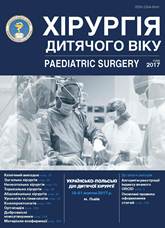Treatment of meconium peritonitis: problems and ways for their solution
DOI:
https://doi.org/10.15574/PS.2017.56.61Keywords:
meconium peritonitis, surgical treatment, newbornsAbstract
The objective of research – to conduct the analysis of meconium peritonitis treatment outcomes in newborns and develop an optimal algorithm for the diagnosis and treatment strategy.Material and methods. The work is based on the results of examination and treatment of 28 newborn babies with meconium peritonitis (MP), who were operated in the first days of life in the Clinic of Pediatric Surgery of Ivano-Frankivsk National Medical University. The patients were divided into 2 groups. The first group included 12 patients, who operated in the first study period (2002-2008), the second group – 16 patients, who operated after 2008.
Results. In 78.6% of patients the cause of MP were congenital defects of intestines (atresia, doubling, volvulus), which complicated by necrosis and perforation. In 4 infants volvulus and bowel atresia observed, 5 children had multiple atresias. Localization of perforation in most patients was observed in a small intestine, only in two children – in a colon, and in two cases – in a stomach. In the majority of operated newborns was detected fibro-adhesive form of MP, a third of children had diffuse peritonitis and three patients – cystic form of MP. In patients of the second group we improved surgical treatment, which was based on a differentiated approach to the choice of the method of operation, depending upon the type of MP. Applied differentiated approach to the treatment of infants with MP allowed improving outcomes in children of group II.
Conclusions. The most common cause of MP in our observations was congenital intestinal obstruction that was the indication for surgery. Treatment outcomes in children with MP depend upon its form and pathology that caused it. The worst outcomes we obtained in fibrous-adhesive form of MP. The applied differentiated approach to the surgical treatment based on the form of MP allowed to reduce the incidence of postoperative complications and mortality in operated neonates. Great importance in the improving treatment outcomes in children with MP has its antenatal diagnosis.
References
Аschkraft КW, Holder TM. (1996). Pediatric Surgery. Transl. from English Nemilova TK. SPb; Hardford. 1 : 384.
Podshyvalin AA, Morozov MA, Zykova MA et al. (2011). Meconium peritonitis: clinic, diagnosis, treatment. Kazan Med Journal. 92(6): 873–875.
Nam SH, Kim SC, Kim DY et al. (2007). Experience with meconium peritonitis. J Pediatr Surg. 42(11): 1822–1825.
Grosfeld JL et al. (1996). Gastrointestinal perforation and peritonitis in infants and children: Experience with 179 cases over ten years. Surgery. 120: 650.
Kamata S, Nose K, Ishikawa S et al. (2000). Meconium peritonitis in utero. Pediatr. Surg. Int. 16 (5-6): 377–379.
Foster MA, Nyberg DA, Mahony BS et al. (1987). Meconium peritonitis: prenatal sonographic findings and their clinical significance. Radiology. 165(3): 661–665.
Saleh N, Geipel A, Gembruch U et al. (2009). Prenatal diagnosis and postnatal management of meconium peritonitis. J Perinat Med. 37(5): 53–538.
Rode H, Millar AJW. (2003). Intestinal atresia and stenosis. In: Puri P (ed) Newborn surgery. Arnold, London: 445–456.
Downloads
Issue
Section
License
The policy of the Journal “PAEDIATRIC SURGERY. UKRAINE” is compatible with the vast majority of funders' of open access and self-archiving policies. The journal provides immediate open access route being convinced that everyone – not only scientists - can benefit from research results, and publishes articles exclusively under open access distribution, with a Creative Commons Attribution-Noncommercial 4.0 international license(СС BY-NC).
Authors transfer the copyright to the Journal “PAEDIATRIC SURGERY.UKRAINE” when the manuscript is accepted for publication. Authors declare that this manuscript has not been published nor is under simultaneous consideration for publication elsewhere. After publication, the articles become freely available on-line to the public.
Readers have the right to use, distribute, and reproduce articles in any medium, provided the articles and the journal are properly cited.
The use of published materials for commercial purposes is strongly prohibited.

